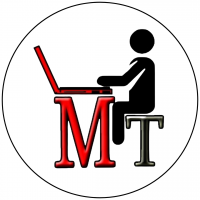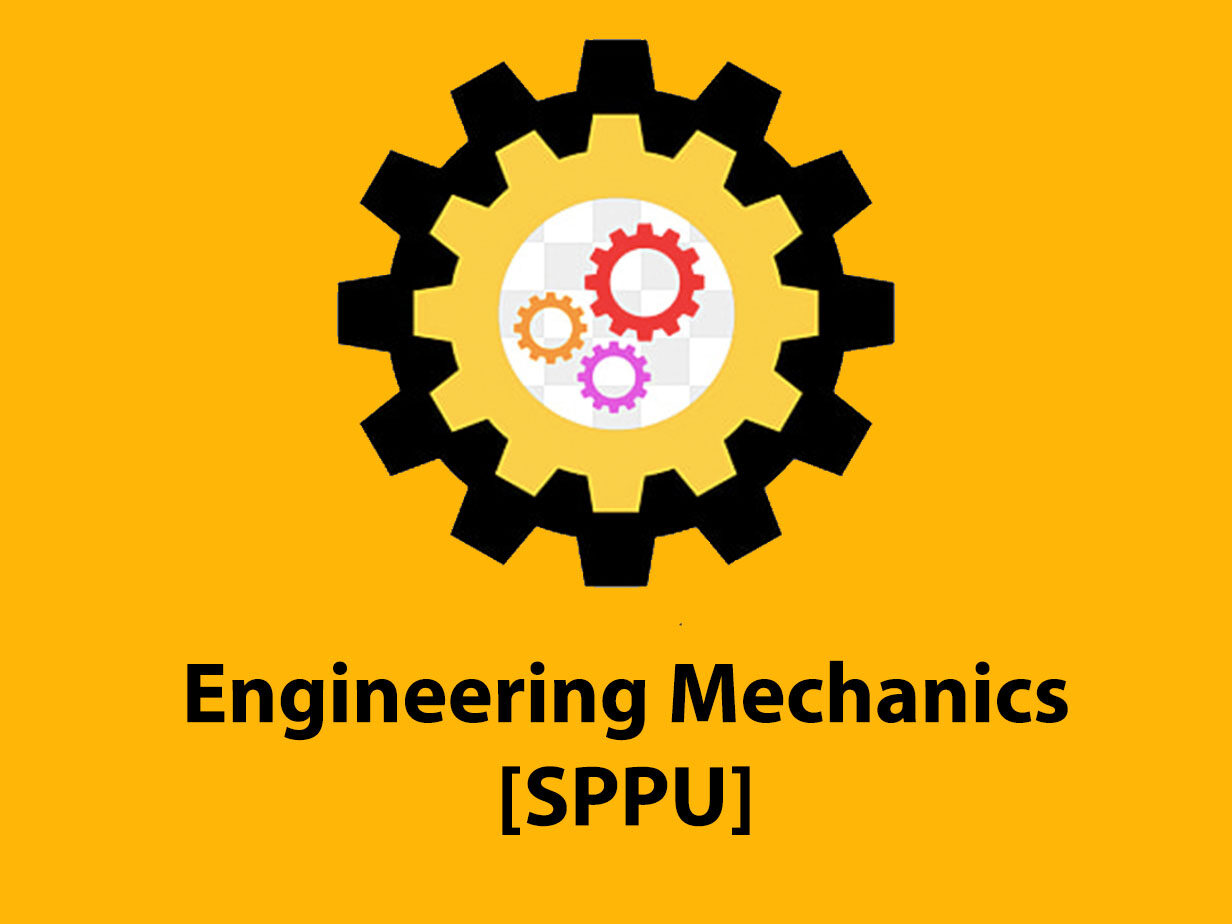Engineering Mechanics
Engineering Mechanics is semester 1 subject of final year of computer engineering in Mumbai University. Objectives of the subject Engineering Mechanics is to familiarize the concept of equilibrium and friction. To study and analyze motion of moving particles/bodies.
Outcomes of the subject Engineering Mechanics Learners will be able to Illustrate the concept of force, moment and apply the same along with the concept of equilibrium in two and three dimensional systems with the help of FBD. Demonstrate the understanding of Centroid and its significance and locate the same. Correlate real life application to specific type of friction and estimate required force to overcome friction. Establish relation between velocity and acceleration of a particle and analyze the motion by plotting the relation. Illustrate different types of motions and establish Kinematic relations for a rigid body. Analyze particles in motion using force and acceleration, work-energy and impulse momentum principles. Friction is the force resisting the relative motion of solid surfaces, fluid layers, and material elements sliding against each other. There are several types of friction. Dry friction is a force that opposes the relative lateral motion of two solid surfaces in contact. Dry friction is subdivided into static friction (“stiction”) between non-moving surfaces, and kinetic friction between moving surfaces. With the exception of atomic or molecular friction, dry friction generally arises from the interaction of surface features, known as asperities. Fluid friction describes the friction between layers of a viscous fluid that are moving relative to each other. Lubricated friction is a case of fluid friction where a lubricant fluid separates two solid surfaces. Skin friction is a component of drag, the force resisting the motion of a fluid across the surface of a body. Internal friction is the force resisting motion between the elements making up a solid material while it undergoes deformation.
Prerequisites for the subject Engineering Mechanics Resolution of a forces. Use of trigonometry functions. Parallelogram law of forces. Law of triangle. Polygon law of forces, Lami‘s theorem. Concepts of Vector Algebra. Uniformly accelerated motion along straight line, motion under gravity, projectile motion, Time of flight, Horizontal range, Maximum height of a projectile. Law of conservation of Energy, Law of conservation of Momentum, Collision of Elastic Bodies. Module System of Coplanar Forces consists of the following subtopics Classification of force systems, Principle of transmissibility, composition and resolution of forces. 1.2 Resultant: Resultant of coplanar and Non Coplanar (Space Force) force system (Concurrent forces, parallel forces and non-concurrent Non-parallel system of forces). Moment of force about a point, Couples, Varignon‘s Theorem. Force couple system. Distributed Forces in plane. 06 Centroid: First moment of Area, Centroid of composite plane Laminas. Module Equilibrium of System of Coplanar Forces consists of the following subtopics Conditions of equilibrium for concurrent forces, parallel forces and nonconcurrent non- parallel general forces and Couples. Equilibrium of rigid bodies free body diagrams. Equilibrium of Beams: Types of beams, simple and compound beams, type of supports and reaction: Determination of reactions at supports for various types of loads on beams. (Excluding problems on internal hinges). Module Friction consists of the following subtopics Revision of Static Friction, Dynamic/ Kinetic Friction, Coefficient of Friction, Angle of Friction, Laws of friction. Concept of Cone of friction. Equilibrium of bodies on inclined plane. Application to problems involving wedges and ladders. Module Kinematics of Particle Motion of particle with variable acceleration. General curvilinear motion. Tangential& Normal component of acceleration, Motion curves (a-t, v-t, s-t curves). Application of concepts of projectile motion and related numerical. Kinematics of Rigid Body: Translation, Rotation and General Plane motion of Rigid body. The concept of Instantaneous center of rotation (ICR) for the velocity. Location of ICR for 2 link mechanism. Velocity analysis of rigid body using ICR. Module Kinetics of a Particle consists of the following subtopics Force and Acceleration: Introduction to basic concepts, D‘Alemberts Principle, concept of Inertia force, Equations of dynamic equilibrium, Newton‘s second law of motion. (Analysis limited to simple systems only.) Kinetics of a Particle: Work and Energy: Work Energy principle for a particle in motion. Application of Work – Energy principle to a system consists of connected masses and Springs. Kinetics of a Particle: Impulse and Momentum: Principle of linear impulse and momentum. Impact and collision: Law of conservation of momentum, Coefficient of Restitution. Direct Central Impact and Oblique Central Impact. Loss of Kinetic Energy in collision of inelastic bodies.
Suggested References books for the subject Engineering Chemistry-I by Mumbai university are as follows Engineering Mechanics by R. C.Hibbeler. Engineering Mechanics by Beer &Johnston, Tata McGrawHill. Engineering Mechanics by F. L. Singer, Harper& RawPublication. Engineering Mechanics by Macklin & Nelson, Tata McGrawHill. Engineering Mechanics by ShaumSeries. Engineering Mechanics by A K Tayal, UmeshPublication. Engineering Mechanics by Kumar, Tata McGrawHill. Engineering Mechanics (Statics) by Meriam and Kraige, WileyBools. Engineering Mechanics (Dynamics) by Meriam and Kraige, WileyBools.
Prepare For Your Placements: https://lastmomenttuitions.com/courses/placement-preparation/
![]()
/ Youtube Channel: https://www.youtube.com/channel/UCGFNZxMqKLsqWERX_N2f08Q
Follow For Latest Updates, Study Tips & More Content!
Course Features
- Lectures 19
- Quiz 0
- Duration 24 weeks
- Skill level All levels
- Students 210
- Assessments Yes
Curriculum
- 1 Section
- 19 Lessons
- 24 Weeks
- Videos19
- 1.1Introduction to Coplanar forces24 Minutes
- 1.2Resultant of General Forces13 Minutes
- 1.3Resultant of Concurrent Forces using Parallelogram law8 Minutes
- 1.4Resultant of Parallel System17 Minutes
- 1.5Resultant of Concurrent System using Method of Resolution23 Minutes
- 1.6Friction Full Basic Concept17 Minutes
- 1.7Angle of friction and Angle of repose13 Minutes
- 1.8Friction Solved Problem30 Minutes
- 1.9Ladder Friction Sums14 Minutes
- 1.10Ladder Solved Example24 Minutes
- 1.11Wedges Problems in Friction27 Minutes
- 1.12Equilibrium in Coplanar Forces11 Minutes
- 1.13Lamis theorem | Equlibrium of Forces |11 Minutes
- 1.14Couple Full Concept in Mechanics10 Minutes
- 1.15Equilibrium of connected Bodies with solved Examples23 Minutes
- 1.16Introduction to Trusses with solved example16 Minutes
- 1.17Truss | Method of Section Explained with solved example14 Minutes
- 1.18Truss | Method of Section with solved example| part 2 |27 Minutes
- 1.19Method of Joints Explained | Analysis of Truss |35 Minutes


![First Year Sem 2 MU NEP [ Comps – IT – AIML Branch ]](https://www.informaltuitions.in/wp-content/uploads/2020/02/WhatsApp-Image-2020-06-26-at-12.15.44-PM-400x250.jpeg)
![Programming of Problem Solving [RTU]](https://www.informaltuitions.in/wp-content/uploads/2021/04/programming-of-problem-solving-400x250.jpg)
![Engineering Maths 2 [RTU]](https://www.informaltuitions.in/wp-content/uploads/2021/04/WhatsApp-Image-2021-04-11-at-4.55.25-PM-3-400x250.jpeg)
![Engineering Maths 1 [RTU]](https://www.informaltuitions.in/wp-content/uploads/2021/04/WhatsApp-Image-2021-04-11-at-4.55.25-PM-400x250.jpeg)